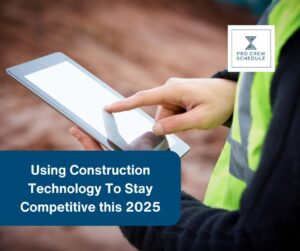Generally speaking, people have long accepted the possibilities of machines making their own decisions and actions. The verge of that is now a trend in the industry, with the Internet of Things (IoT). It’s quickly transforming the world as we know it, with traffic lights, machines, and vehicles that are communicating and connecting. One of the most common ways the IoT is communicating and collecting data is using sensors.
While the technology in construction has been around for quite some time, the incorporation of sensors in the personal and business setting is gaining attraction. In fact, the use of the sensor is growing exponentially in construction businesses as our world further embraces advanced technology. Worldwide, the demand for sensors is expected to reach up to $27 billion by the year 2022.
Sensors and IoT in construction are explored explicitly on a deeper level and incorporated to improve daily operations. Suppose you’re looking to start or even optimize the use of sensors in construction. In that case, we’ll explore specific use scenarios for the technology and what opportunities they offer for the present and future of the construction industry.
How Are Sensors Used in the Construction Industry
Sensors are able to measure a variety of data. How is the data received by the sensors communicated? Through IoT. This information is essential since 94% of businesses have experienced a positive Return of Investment with IoT investments.
With this, we can move to the question of how IoT is utilized in managing construction- this technology helps monitor construction job sites. It uses old data to predict patterns and prevent potential risks rather than only focusing on corrective steps once something goes wrong. This precautionary approach helps save valuable resources, such as time and money, providing more efficient construction operations. Nevertheless, IoT can also offer corrective action when needed.
How can the traditional construction industry infiltrate into the world of and potentially return-worthy sensor tech? One significant way is through the use of wearables. Far from public knowledge, construction workers can now put on devices in their uniforms or bodies while performing activities on a job site. These devices can then collect, monitor, and share data with the user and with other tools and devices through the IoT.
While wearable tools and technology in construction are just starting points, you will notice its appeal more as these wearables show valuable insights into the construction industry. For example, wearable construction sensors share real-time physical states of workers, performance levels, operating conditions, tool management, and much more. They can also share data about the job site and the workers, offering a vast potential to improve productivity, safety measures, and other standards.
4 Ways to Incorporate Sensors in Construction
As previously mentioned, the use of sensors can help us make the construction industry better by enhancing business operations with the help of more data. But what improvements can they implement anyway? Below, we’ll dive into four areas in construction that will undoubtedly advance with the use of sensor technology.
1. Monitor Conditions in Construction Job Sites
Sensors that can be connected through wifi or data can help us enhance the productivity and safety of construction sites by relaying vital information regarding site conditions. For instance, sensors can alert us on humidity levels and other weather info that might impact building materials (especially concrete) and schedule (like concrete pouring) and the safety of workers.
Looking back at history, our ancestors looked for gas leaks by covering themselves with wet blankets while holding a lit wick, or when feeling cautious, by seeing how a canary bird reacted. Later on, they switched to flame lights and then transitioned to modern solutions using monitor devices. Now, we are advancing to the next level of gas leak detection by incorporating sensor technology, which offers a more modern and practical approach. It can also determine other problems that we can’t detect with average human senses, such as chemical incidents.
2. Enhance Inventory Management
Incorporating sensors in construction allows a company to track materials or equipment in real-time through inventory monitoring so businesses can stay on top of their game. This promotes more efficient inventory management, improved ability to stick to project budget and timelines, and better communication with clients. Even during and after the construction, some companies are still using sensors in monitoring the post-construction and long-term health of building materials such as concrete.
Sensors can also aid with equipment management by presenting valuable data on the status of the construction equipment a company owns. This is especially important in inventory management in construction. As most construction professionals know, equipment maintenance is an expense that can be too expensive if not managed and maintained adequately. Sensors can help avoid more costly repairs and replacements by showing real-time data and offer predictive maintenance that reduces machinery repairs and breakdowns.
3. Foster Safety of Construction Workers
Ensuring safety on construction job sites is vital to keeping employees productive and healthy and maintaining insurance costs low. A company that takes safety as a priority promotes an effective job site and prevents a string of problems, such as lousy company branding and lost projects.
Sensor-typed wearables help with this area by improving site and worker safety. Environmental sensors provide data on the construction site conditions that affect safety. On the other hand, conventional biometrics sensors monitor the people on the site, such as time-in and time-outs on a daily workday. However, more advanced biometric sensors can track heart rate, body temperature, repetitive motions, posture, and other cues. This vital information could help prevent accidents and injuries while also alerting the team if slips and falls, heat exhaustion or fatigue, or other health-related problems occur.
On top of preventing incidents, sensors also help safety by significantly cutting down on the response time if an incident does occur. Additionally, they help the general contractor manage a construction project in general and aids in better construction crew management.
4. Develop Better Management of Facilities
Finally, sensors can empower facility management. Although this feature of sensors is right now an under-utilized innovation, it is growing technology as collecting data points to more potential in the future.
Sensors can now be integrated into a BIM model once a structure provides relevant data about a building. More data gives you more perspective over factors such as energy usage, temperature patterns, and foot traffic. In facilities that are heavily operated and include high-tech machinery and amenities, such as hospitals, having a real-time outlook of the inner workings of a building is critical for maintaining long-term costs. By utilizing this information correctly to make more efficient decisions for future projects, you have the potential to save millions of your budget in the long run.
The First Step in Implementing Sensors in the Construction Industry
So, are you now on board with the idea of using sensors in construction? Now, the next step is knowing how to implement them within your company and construction projects. Luckily, now that sensor technology is becoming more common, it is becoming more affordable to implement in project management for construction. You will find companies that create sensors specifically for the construction industry which collect data in real-time and utilize it within a risk management tool to provide analysis and resets. These sensors go around the construction site and identify environmental and other factors affecting the job’s productivity and safety.
But no worries, if your company still can’t support the full implementation of sensors, you can still start using this technology on a smaller scale. Begin by identifying a few critical areas in your business that you think would make the most impact. For instance, is it a higher priority to focus on worker safety or productivity first? Then, expand your technology over time.
Lastly, as we mentioned previously, sensor wearables give a smart and fun way to use this innovation too; They can be embedded into personal protective equipment such as vests, boots, gloves and hard hats, and even to worker’s clothing! Sensors will then connect information on both the environmental conditions and workers. If you’re reevaluating or improving your PPE program, including wearables might be a great way to overall worker safety.
Key Takeaways
Whether you use sensors through worker’s wearables or in a full-on construction setting, they bring exciting possibilities to the construction industry. They can help with many difficulties of the sector, including enhancing worker safety, creating more efficiency, improving construction inventory management systems, and boosting client communication and satisfaction.
With a good implementation plan, sensors can help move your construction business into a smarter future. However, the key is to integrate your sensor data into your other software platforms. Connect it with an integrated construction management platform that improves processes within every area of your business.







